Key Measurements for a Wine Cellar, Part 2
http://decor-ideas.org 05/27/2015 05:13 Decor Ideas
As discussed in Part 1 of this two-part look at wine cellars, abundant choices are available in premanufactured systems to properly store your wine collection. The only problem with those is the limitation on the number of bottles that can be stashed. If this is your challenge, you may want to consider adding a wine bar or a full wine cellar to your home. Whether you want something closet sized or room sized, understanding a few key dimensions will help you plan yours so that you can always keep a good selection of your favorite vintages at the ready.
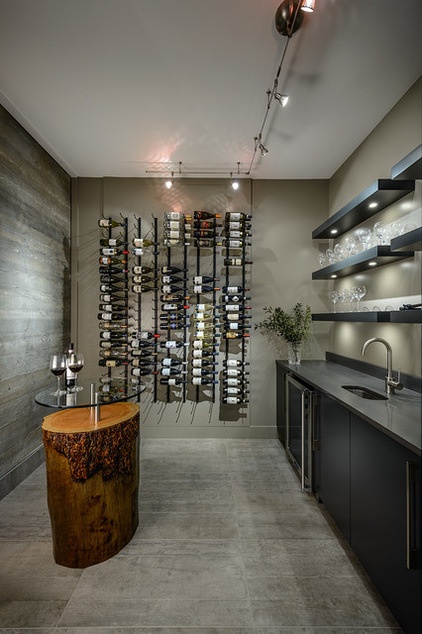
The first two examples employ a small undercounter wine chiller used to get the wine a perfect temperature. As well, the few different ways used to store and present the collections give these spaces interest. Installing wine racks that place the bottles horizontally and parallel to the wall will allow you to easily see the labels, which will let you locate that perfect bottle more quickly. Combining this type of system with a diamond bin, seen below, allows a variety of ways to store the wine.
When planning your wine cellar, keep in mind the common dimensions of a 750-milliliter bottle: about 3 inches (7.6 centimeters) in diameter and 12 inches (30.4 centimeters) high. For example, if you allow 14 inches (35.5 centimeters) of width per rack and 4 inches (10.1 centimeters) of height per bottle, a racking system that is 56 inches (154.5 centimeters) wide and 84 inches (213.3 centimeters) high will hold 84 bottles at maximum. The advantage is that you need much less depth than configured in a conventional diamond bin or wooden rack. There are numerous rack systems on the market that you can buy and easily install. Just keep in mind the weight. An 84-bottle rack will need to securely hold about 250 pounds of wine.
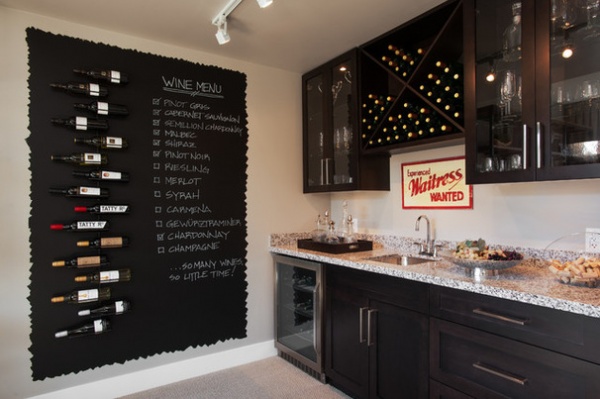
Below is just one example of a manufactured wine rack available on Houzz.
Browse thousands of other wine racks
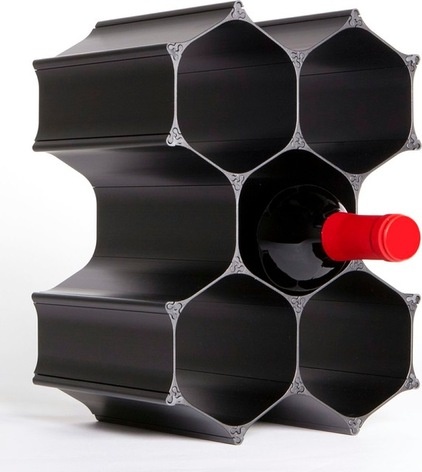
Black WineHive 6-Bottle Modular Wine Rack - $89.25To not get overwhelmed with so many choices, carefully consider what types of wine racks will work for you, then search for that specific type. Simply enter any description you can imagine into the search box at the top of this page and a drop down menu will appear that will allow you to choose “in Shop.” The more specific you can be, the more likely you will find what you’re seeking.
As examples, start with these searches:
Wire wine racks
Metal wine racks
Wooden wine racks
Plastic wine racks
Horizontal wine racks
Bin wine racks
Case wine racks
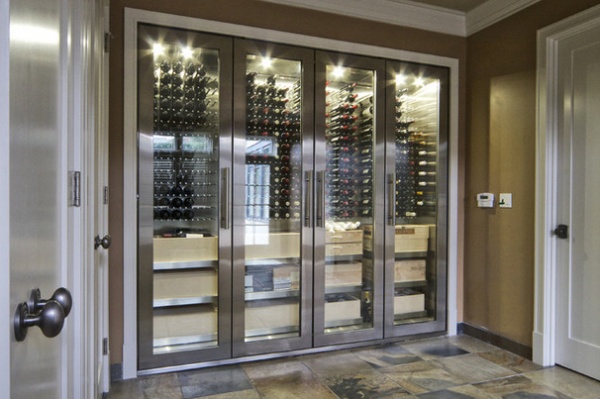
Similar to manufactured tall wine refrigerators is this custom-built system that stores almost 400 bottles. Notice that the designer has allowed for wine racks plus cases of wine in boxes in the lower section. If each door is 24 inches wide, you will need 8 linear feet (243.8 centimeters) of wall space plus the depth and height to accommodate a similar configuration.
If each door is 30 inches (76.2 centimeters), then you’ll need 10 linear feet (304.8 centimeters). You’ll also need a minimum of 3 feet (91.4 centimeters) of clear space in front of each door to properly open, close and access the system. The total floor space for 10 linear feet (304.8 centimeters) of wine storage plus the access is going to be an area that is about 10 feet (304.8 centimeters) long and 6 feet (182.8 centimeters) wide, for a dedicated area of 60 square feet (5.6 square meters).
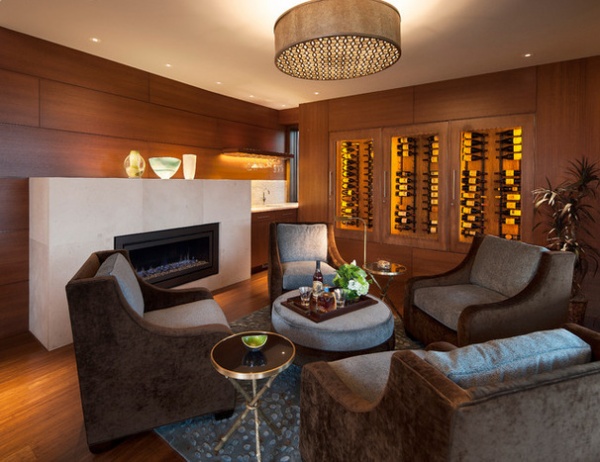
This custom-designed wine closet elegantly displays the wine collection with ambient lighting through clear glass doors. If you don’t choose self-contained refrigeration units as described in Part 1, wine storage like this must be cooled by proper mechanical systems specifically designed for this purpose. At this level you will likely need to employ a business that specializes in building wine cellars, or have your architect and interior designer work with the company.
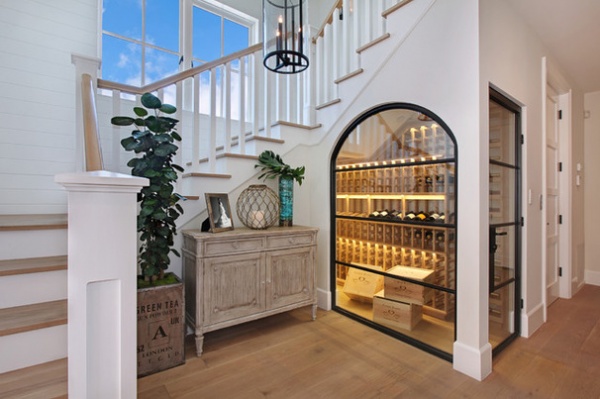
An awkward, underutilized space beneath stairs can provide an extraordinary and convenient opportunity to build a stunning wine cellar. The nature of the beast allows you to place bottle storage in angular spaces, places where most household objects would never fit. While it is ideal to have at least 3 feet (91.4 centimeters) in front of wine racks to access them, the configuration above still works with rows of typical wooden wine holders and one row for presentation view. An area of about 21 to 24 inches (53.3 to 60.9 centimeters) to the glass wall encloses the space in which to maneuver. In the cellar below, parallel wine racks solve the issue of tighter constraints.
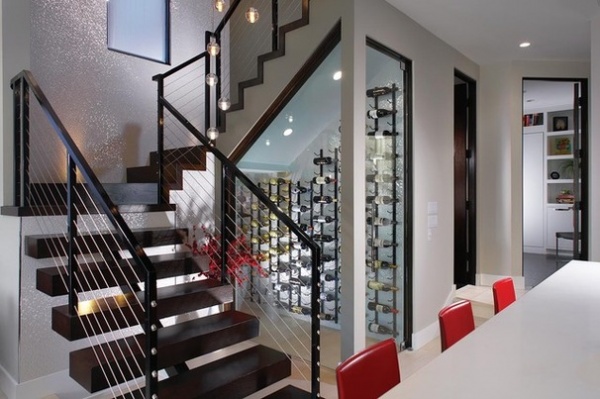
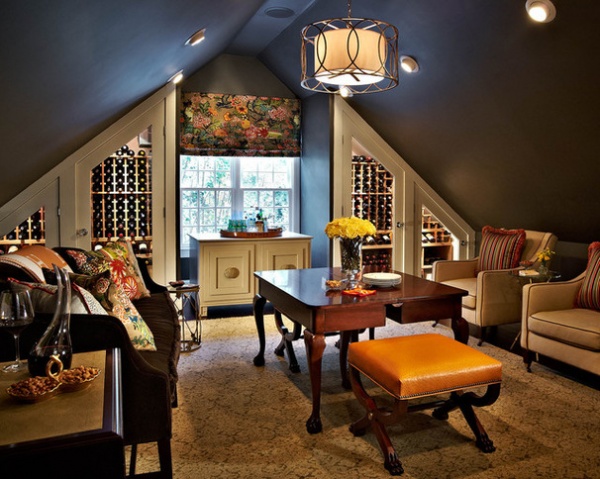
If an impressive presentation is your goal and your budget is significant, you can create a stunning wine cellar. The attic wine cabinet above is tucked nicely under the roofline. Refrigeration units must be correctly sized and specified for such configurations. Equipment dimensions vary, so involving professionals for these is recommended.
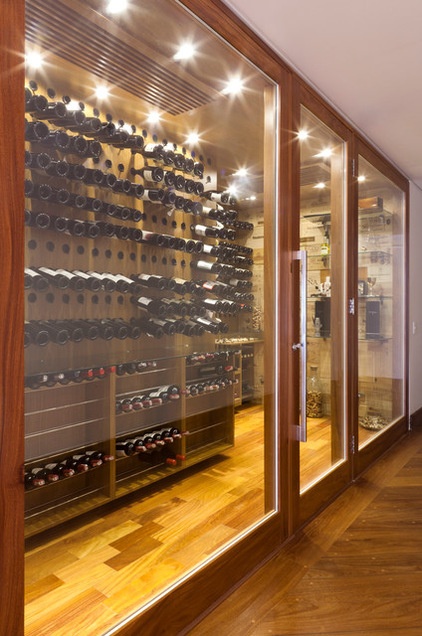
There are many creative ways to hold bottles. The glass-enclosed wine closet here has two unique options. The upper wall is outfitted with holes of about 1½ inches (3.8 centimeters) in diameter; each houses a special plastic clip that keeps the bottle nearly horizontal but allows a good view of the label. The lower racks are accomplished by the installation of two metal dowels.
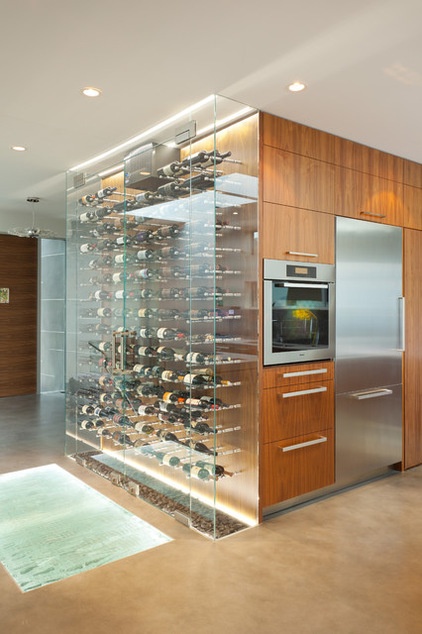
A more recent trend has been to build a glass-enclosed wine cellar within the living area of the house, usually next to the dining room. In the cabinet here, the refrigeration unit is visible at ceiling level. Dramatic lighting and details such as the unique rack design make it a success. The rack is made of a series of custom metal rods anchored into the rear wall. Enclosures such as this are similar to those made for glass showers.
Extreme climates are not the best candidates for spaces like these. Keep in mind that the desired temperature is about 57 degrees Fahrenheit (14 degrees Celsius) and with higher humidity. If you live in a hot climate, maintaining the correct balance with glass walls could be a challenge.
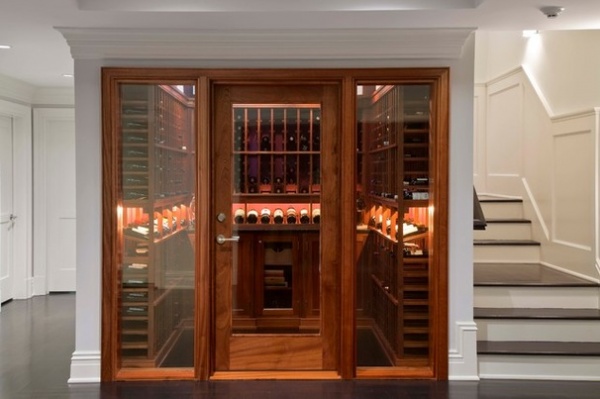
For true wine aficionados, a full room may be required to house their collections. In the 8- by 9-foot (243.8- by 274.3-centimeter) wine cellar above, conventional wooden racks hold most of the bottles. A display rack is part of the scheme at about counter height, so that some bottles can be quickly identified. The lower back wall holds a humidor and some space for cases of wine behind cabinet doors. The racks in this arrangement are about 12 inches (30.4 centimeters) deep, so at these dimensions, there is about a 6-foot (182.8-centimeter) square space to open the door into and to move about in.
The wine room below appears to be much larger than this example. Parallel racks in which the necks of the bottles overlap allows more stowage than would otherwise be available in this configuration. While this arrangement might allow less wine storage per square foot, finding a particular bottle is easier than in conventional storage.
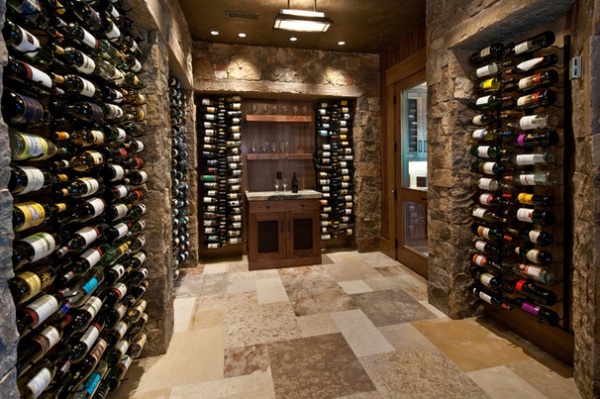
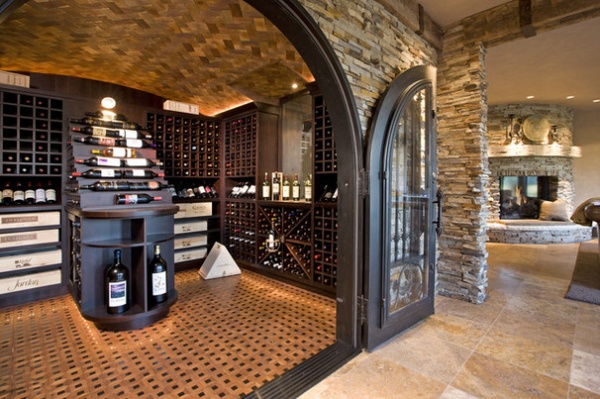
This large wine cellar illustrates several conventional storage solutions. Cases are placed on lower shelves, while square cubbies provide most of the storage. A diamond bin has been built under the window to the right, and display shelves have been set at counter height. The peninsula houses a few oversized bottles with a spot to place a few to be easily accessed.
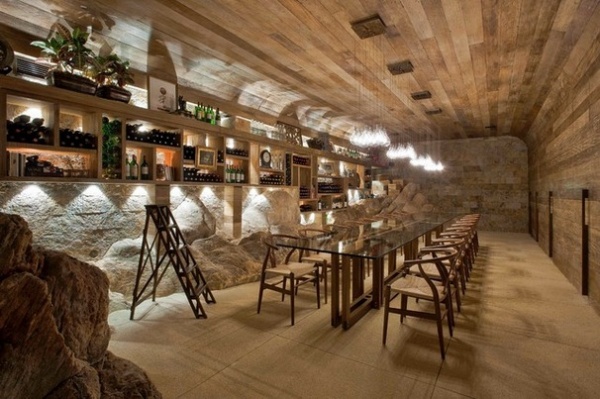
When space is plentiful and you literally have a cave to build into, the placement of your collection can be quite generous. This marvelously artistic arrangement of wine bottle shelving coupled with objects is a very elegant solution. The depth of the shelves is still only about 12 inches (30.4 centimeters), but the expansive breadth of this room allows an entire long wall dedicated to storage at a perfect eye-level height.
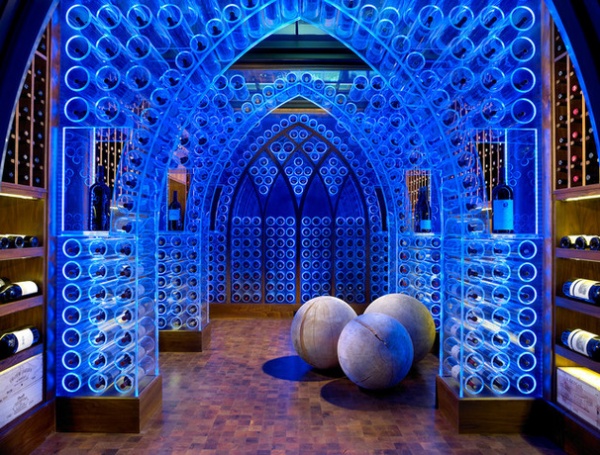
When the budget is unlimited, a wine cellar can be an extraordinarily dramatic space, as evidenced here. Generously proportioned acrylic Gothic-style arches house bottles, while colored LED lighting illuminates the scene in moody hues. LED lighting should not be harmful to wine. Sunlight and fluorescent light are problems. Note the space allotted for large bottles. As mentioned earlier, providing a few spots for unusual sizes is always a good idea.
When planning your project, keep the illustrated list below at hand so that you can build a wine cellar that fits your requirements.
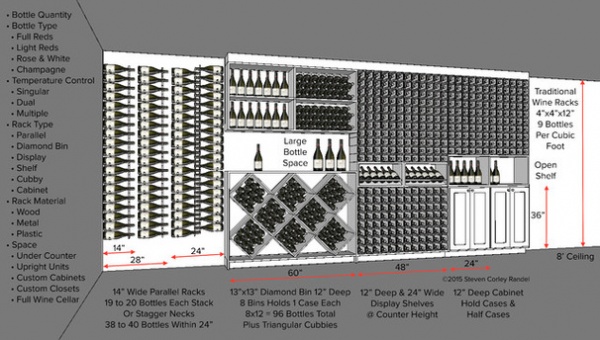
More:
Key Measurements for a Wine Cellar, Part 1
Browse other stories in the Key Measurements series
Related Articles Recommended












